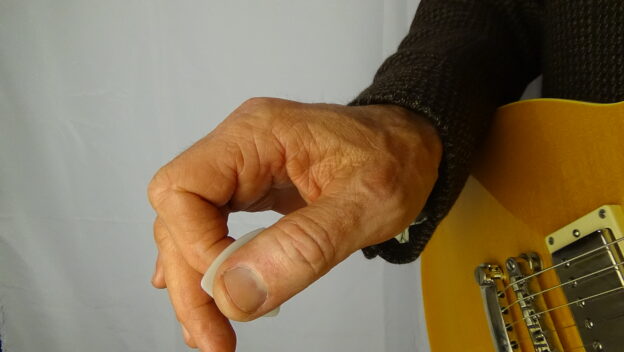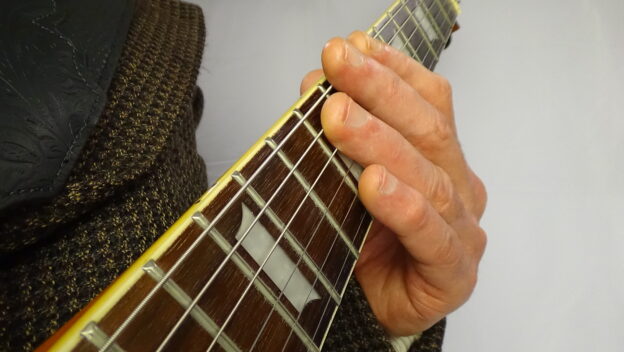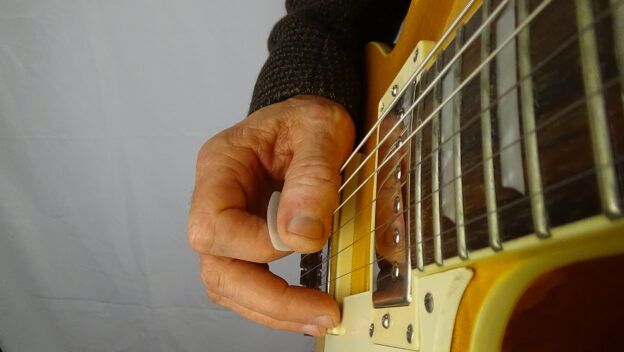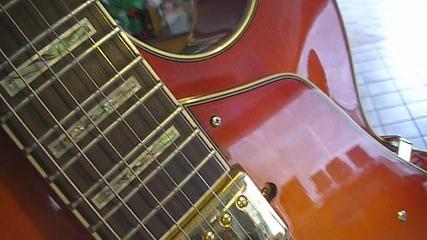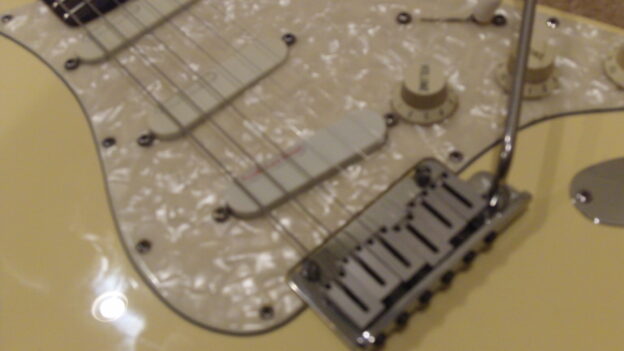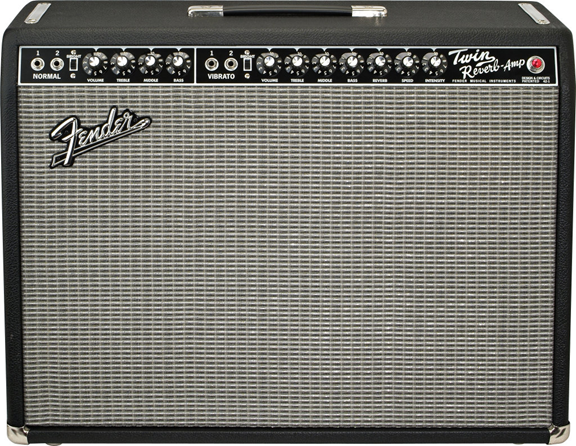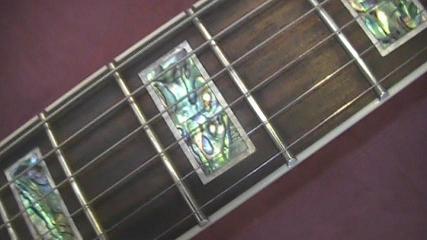by PMI Guitar Instructor Chad Crawford
Can I Help You?
Having played and taught guitar for many years now I have accumulated a great deal of insight into what works and what doesn’t, both in regards to teaching methods and the approaches students take to learning music. When I started out with teaching I had a number of concerns as to how effective I would be at communicating, what materials I would use, how to organize and present them, if my gruff personality was suitable for teaching, and so forth. I was mostly concerned with things about me. What I have found with experience is that the number one obstacle I face as a teacher is not about me at all. It is, rather, something that is unfortunately beyond my control. It is something in my prospects and clients, which I should have known from general life experience would be the case, as it always is with everything in human affairs: attitude.
The Singular Importance of Attitude
Probably the single most important thing I have learned in my decades of musical endeavor is that music is not just about technical matters pertaining to managing the fingers or voice effectively. Rather, it is mostly a matter of cultivating the mind, and that means among other things that a person’s overall attitude about life, work, and people is going to have a great deal of impact on his or her accomplishment as a musician. As with any “rule” there will certainly be notable exceptions, but they will be notable because they are exceptions. Mastery of things technical is certainly very important, but the foundation of it all is mental attitude. Can I help you? Well … it depends very much on your attitude. That terminology is often used in a way to imply contempt, as in “He has an attitude!” That’s not the way I am using it here. I don’t say it here with any kind of judgmental intent. It is just an objective fact. To illustrate, let’s look a bit at some examples of how attitude effects musical results.
Why Me? – In my initial consultations with prospects I always inquire as to their expectations regarding time frames, because I know there are many people who for whatever reason think that they should be able to play guitar like a professional after a few months of lessons. That was something that caught me off guard when I started teaching. I started playing very young and have been around musicians all my life, and it being thought to be quick and easy was never a part of the picture for me or any other musician I knew.
Early on in teaching I observed that a lot of people had very little patience for the process. Some would even blame my teaching if they could not play like a pro in a matter of weeks, and then quit. Others would blame themselves for “lack of talent” and quit. In both cases they were suffering from the “Why Me” syndrome, an idea that the challenges they were facing were unique to them, and either insurmountable, or else some else’s fault – such as their teacher. They were completely off base in both cases, because their expectations had no basis in reality. I couldn’t help them because they were evaluating their playing skills according to unrealistic criteria.
Learning guitar is challenging, and it takes time. The loftier the goal, the harder it is, and the longer it takes. That’s the way it is, despite common claims from some web marketers. There are shorter and longer paths, and a great teacher can cut years off the timeline, but it is still going to take substantial time, effort, and commitment. Beginners should be thinking in terms of years rather than weeks. There will be times of mind-numbing repetition accompanied by apparent stagnation, followed by a shift in fluency, or occasionally a major breakthrough when a number of hard-won gains come together at once. That’s normal. You can’t take the struggles personally, as if it is something unique to you. If you do give in to taking it personally, the bad news is that I can’t help you.
The good news is that if you’re willing to discipline yourself toward working your way through an ongoing process, and choose to stay focused on your goals rather than the barriers of the moment, then I can help you a great deal!
Why Not Me? – Despite my never ending studies of books, lesson videos, and previous private lessons with a number of teachers, I am ultimately responsible for my progress and competence as a musician. Some of my sources were fantastic, but I still had to do the work. Some of my sources were not so fantastic, but it was still my responsibility to improve my skills, even if that meant eventually moving on to another resource or teacher.
As do all good music teachers, I teach music principles and not just song transcriptions. I can’t show students every note to play for the rest of their lives. I teach them how to develop finger control and how to figure music out for themselves. I provide a number of resources outside of my private lessons, such as articles like this one, backing tracks, and a private bulletin board with additional third-party articles covering everything from theory to playing tips to gear. I provide group classes to allow my clients an opportunity for applying what they learn in private lessons to making real music in real time.
What I observe is that very few actually take full advantage of these things. Some do the minimum they can to fulfill the practice schedule I provide (or even less). Some do a little more than that. A few go after every learning outlet I point them to, and it is evident in the results. Those who utilize all the tools I provide, plus doing their own research and study in addition to my lessons, which I fully encourage, those are the students who achieve the fastest and most significant results.
I’m willing to help clients who fit any of the above descriptions, because people have jobs, school, and family obligations competing with their time for music. I well understand all that because I share in the same struggles. If you are truly doing all you can do, then that’s all you can do and I do not intend to beat you over the head about it. If that’s you then I encourage you to stick with it and be patient.
I know that many students of music, not only mine but in general, could do more and they simply choose not to. Some former students have blamed their frustration with slow progress or stagnation on me or my lessons. Sometimes they have let me know this in one way or another, either through direct challenges to my lesson materials or methods, or else in more subtle ways. I do what I can to steer them out of this kind of self-defeating thinking, but I can’t force anyone to learn guitar. I am responsible for providing an effective course of instruction, encouragement, and accountability, but I cannot be responsible for results. Responsibility for results lies with the student.
I can’t help those who blame others or circumstances for their results rather than buckling down and doing the work. Whether you take lessons with me or attend Berklee for eight years, your progress and competence as a musician is ultimately up to you. If you allow yourself to side-step that responsibility, I can’t help you.
If you will commit to learning guitar up front and then persevere through the process, following the instructions and taking every avenue and opportunity presented to you toward improvement, and taking full responsibility for your results, then I can help you a great deal!
It’s My Hands! – No it isn’t, unless you have health problems that constrain them. Your hands are incredibly capable, stunningly engineered grappling machines. Beyond your instinctive programming for certain basic movements, your fingers do exactly what you tell them to do. Technique then is the result of a process of training your mind. You may object that you know what you are trying to do but you can’t get your hands to do it. I assure you that though it may feel that way, it is not the case. When you play guitar your hands are doing exactly what the messages from your brain are telling them to do. They are not capable of doing anything else. If your messages are flawed your results will be flawed. You have to repair and refine the messages, and the way you do it is through programming correct messages into your brain’s muscle memory. This means repetition of the right movements. In contrast to a computer, programming the brain takes a lot of repetitions. A lot.
However, it also means this: the subtleties of good technique are in timing and dynamics. This comes more from general musical sensibilities rather than muscle memory. Musical sensibility is a product of a well-developed ear for pitch and time combined with an overall sensitivity to flows of tension and release. Musical fluency comes from knowing what will sound good before involving your fingers. This comes from studying the music that others have made, and from experience with applying a high level of sustained mental focus to practice and playing situations. That’s why it is important to analyze great music rather than just practicing rhythm and phrasing. Physical control is essential, but the target is what you have programmed into your musical sensibilities from analyzing the masters. If you have no clear target then you will not shoot straight. So you must understand that the battleground for progress as a musician is in your mind, not your hands! If you are committed to thinking your musical limitations are in your fingers, I’m sorry to say I can’t help you.
If you will embrace music as a whole body-mind phenomenon rather than just finger gymnastics, then I can help you a great deal!
It’s My Genes! – I started my musical journey playing bluegrass rhythm guitar with a family ensemble. I enjoyed bluegrass music and still do, but the first time I heard Eddie Van Halen’s monster guitar solo ‘Eruption’, I was bound for new pastures. I also quickly realized I had no idea how to extract any sounds like that from the guitar. At the time there was no Internet, so I didn’t have convenient access to virtually unlimited resources to explain how he was doing this stuff. I didn’t even know what “tapping” was. I quickly concluded that he was some kind of musical freak show and that his sort of playing was not accessible to me.
How I wish I would have had someone to explain things to me then! First of all it would have been helpful to know that Eddie Van Halen came from a family of musicians where he was vigorously encouraged, and even compelled against his will, to learn music from an early age. He was forced into piano lessons very young, then experimented with drums a bit before picking up guitar. It would also have been helpful to me to know that his signature tapping technique was stolen. Yes. Stolen! Like all guitarists, he did not just make up a new style of guitar playing that no one had ever heard of. He picked up the tapping technique from observing many guitarists who went before him, then developed it and put his own twist on it. It would also have been helpful to me to know that he developed his chops in a small-scale cover band before anybody knew he was a big deal, and also that he learned much from transcribing Eric Clapton songs by ear. The fact that he could do that in his teens had a lot to do with the early piano and drum experience.
If I had known all that then I would have also known that it had little to do with “natural talent”, but rather had a lot to do with POW – “plain ol’ work”. Then I would not have been inclined to give up so readily when I ran into difficulties learning my favorite songs, letting myself off the hook with the excuse, “I just don’t have that level of talent”. If I had just known that Eddie Van Halen also had to work at it for a long time, just that one little bit of information would have totally changed my approach to learning guitar and I would have become a much better musician much earlier in life.
Do you think that musical skill is reserved for the gifted few? If you do, and if I can’t talk you off of that motivation-killer, then you will not persist through the challenging times when your hands and memory seem to be defying your best efforts, and so, as much as I want to … I can’t help you.
If you will accept the fact that music skills are the result of persistent effort, and you will commit up front to doing the work until you get the results you seek, then I can help you a great deal!
Show me the Magic! – I see a lot of Internet advertising for guitar training featuring the appeal to the quick fix. There are two basic types: (1) “Click for the secret of instant guitar Ninja!”, and (2) “Play great guitar with just a few notes!” The first type is snake oil rubbish. The second type is technically true. There is a catch. You can indeed mine a lot of good phrases out of just a handful of notes, and will do well to learn how, especially for hobbyists with limited time for scale practice. If you do not also command finesse in pick attack, dynamics, bending, vibrato, tone, and rhythmic sensibility then the few-note phrases will sound like a hack slaughtering half of a scale.
The reason people publish these kinds of advertisements is because they work. It is standard marketing practice because it is more effective than laying out the cold facts about work and perseverance, hooking the attention of well-intended but uninformed, frustrated guitarists. Nor do I wish to come across as trashing all Internet marketers. Sometimes a perfectly legitimate service provider will utilize these kind of marketing gimmicks, not intending to defraud but rather hoping to grab the attention with the neon light of the quick fix offer. Then they divert toward a more substantial product. Between the snake oil and the legitimate providers forced to compete with snake oil for attention, I have prospects coming to me with expectations, sown by these prolific ads, that I will show them the “tricks” for rapid fluency.
I meet with all prospective clients for an initial consultation. One thing I am looking to communicate is that I do not deal in the music marketing crack cocaine of the quick fix offer. If they do decide to enroll they know that they are in for a long term process. I continue in the lessons to reinforce the idea that learning music is a long term endeavor. Despite all this pointed effort to clearly set myself apart from snake oil vendors, I still occasionally run up against the call for the quick fix even among my enrolled clients.
A passionate teacher with an organized program of effective learning materials and methods, combined with routine adherence to an effective practice schedule, is the shortest path to musical fluency. There is no magic. There are no tricks. There is no one isolated piece of knowledge or technique insight that is going to suddenly make a radical change to one’s musical ability. It is a process of cultivating mastery of bits and pieces over time. I don’t want clients who are looking for snake oil. It is not because I am mean, it is just that I already know it is going to be a bad experience for both of us. I can’t help those who are looking for magic.
If you’re willing to discipline yourself to working through a proven process which will deliver real results much faster than going it on your own, then I can help you a great deal!
My Way or the Highway! – Having been around the music scene for many years now, I have observed much in terms of how human relations affects the process of learning and performing music. I have seen guitar players play way too loud, way too long, or just plain badly because they have not done their homework. I have seen drummers play so loud that it caused literal pain in other band members. I have seen bass players go off on a disruptive, meandering excursion into jazz fusion when all that was called for was a simple walking pentatonic. I have seen people who thought they were above rehearsal. I’ve seen folks rationalize mediocrity by citing the legitimate dangers of “perfectionism”, but by which they actually meant “me having to do anything that resembles work”. I have seen people who would make a commitment to be somewhere at a certain time, having no intention of fulfilling that commitment, and didn’t care about the impact this had on other band members. I have seen bands revel in silly pride over playing way too loud for the venue. I have seen sound techs who would not trouble themselves to really learn sound management, and so make an otherwise solid band sound like hacks due to a poor mix.
I have seen music teachers who had no real interest in teaching, nor interest in their clients beyond a check, nor anything close to an organized teaching system. I have seen music students who were chronically inattentive, and some who felt no obligation to treat their teacher as a person rather than just an information source. I have seen some who were combative about tuition, and some who didn’t have enough class to notify that they were going to miss a lesson. (As a matter of policy I do not allow these things to go unchecked in my school. If they persist then I decline further lessons.)
All of these troublesome things are symptoms of one underlying problem that is often the root of social tension: failure to practice respect for others.
It is important to recognize that both music training and performing are team endeavors. If you are playing with a band then the team is everyone in the band plus the management. You may not have thought about the team as it applies to other common aspects of musical endeavors. If you are playing with a band in a commercial music venue then the team is not just your band but also the sound tech and staff of the venue. If you are playing solo acoustic/vocal in a coffee shop then the team is you and the coffee shop’s staff. If you are working with a teacher then the team is you and the teacher, or the group and the teacher if you are learning in a group setting. As with all successful team endeavors it requires that everyone submit to a bit of restraint for the team’s success. This is called a win-win deal. It is very important to your success with and enjoyment of music that you strive to cultivate win-win deals with others who are likewise inclined.
There is a simple rule of thumb that will help anyone to cultivate win-win deals: don’t be a jerk, and don’t stick yourself in the mud trying to coax a win-win deal from a jerk.
Here are some of the ways I avoid being a jerk and instead demonstrate respect for my prospects:
I don’t try to entice folks into my programs when I know they want to play in styles that I am not fluent in, and interested in sufficiently, to stay passionate about their ongoing training. I do not proffer marketing claims that I cannot back up with substance, nor otherwise mislead as to what folks can expect from me. I do not allow clients to enroll in my programs without making an effort to communicate to them clearly up front what they are getting into in terms of the commitment required, and how long it will take to reach their goals.
Here are some of the ways I avoid being a jerk and instead demonstrate respect for my clients:
I do not wing it. I utilize an organized course based on personal experience, music teacher training, and countless hours of ongoing study as to what is relevant and effective. I set meaningful goals for the students and carefully track progress. I don’t waste time with gimmicks, filler, or otherwise try to drag the training out needlessly toward retaining revenue for which I am not providing real value. I do not stick clients into a creepy closet with me where they can barely move, nor drag little kids off to a concealed room where their parents can’t see what is going on. I don’t show up to lessons looking like a “rocker” stereotype who just crawled out of the dumpster behind the studio after a week of binge drinking. I avoid phone interaction as much as possible during lessons, and on the rare occasions when it is unavoidable I make it very brief. I don’t take up instruction time indulging my own playing beyond what is necessary for illustration purposes. I don’t allow clients to steer the lessons in directions that I know lead to a dead end, but rather try to balance their immediate interests with my larger view of what they need to reach their goals. I continually research and accordingly update my materials and methods, never letting up on improving my effectiveness.
I could continue, but for brevity’s sake I will stop there and hope I have illustrated that I take my obligations to my customers seriously. I want to enjoy the lessons and I need to make a living, but I put my clients’ results and enjoyment equal to my own interests. I also insist on respect from my clients in return, not only for fairness’ sake but because students get better results from a teacher they respect.
What does all this have to do with the practical realities of making music? It has everything to do with it. If you want to do something with music besides practice in your bedroom all the time then it is good policy to treat others with respect, and accept nothing less in return. If you are working with a teacher or plan to work with a teacher, consider first that the teacher demonstrates respect for clients in ways such as I have mentioned above. Demonstrating respect for your teacher will go a long way in your getting the best effort from your teacher, and consequently the best results for yourself.
I think it was Zig Ziglar who said, “Your attitude, not your aptitude, will determine your altitude!” I’ve seen it often, and I’ve heard it from other teachers and coaches. In most cases a student with average or even below average talent, working with an average teacher, but with a good overall attitude, will in the long run surpass a more inherently capable student who is working with an outstanding teacher, but harboring some variation of self-defeating attitude. Can I help you? Maybe … depends on your attitude. Attitude is the foundation of success, and it is a choice.
In part two of this series next month we will take a closer look at how attitude affects the more technical aspects of developing musical skills.
Copyright © 2005 Palmetto Music Institute. All Rights Reserved


